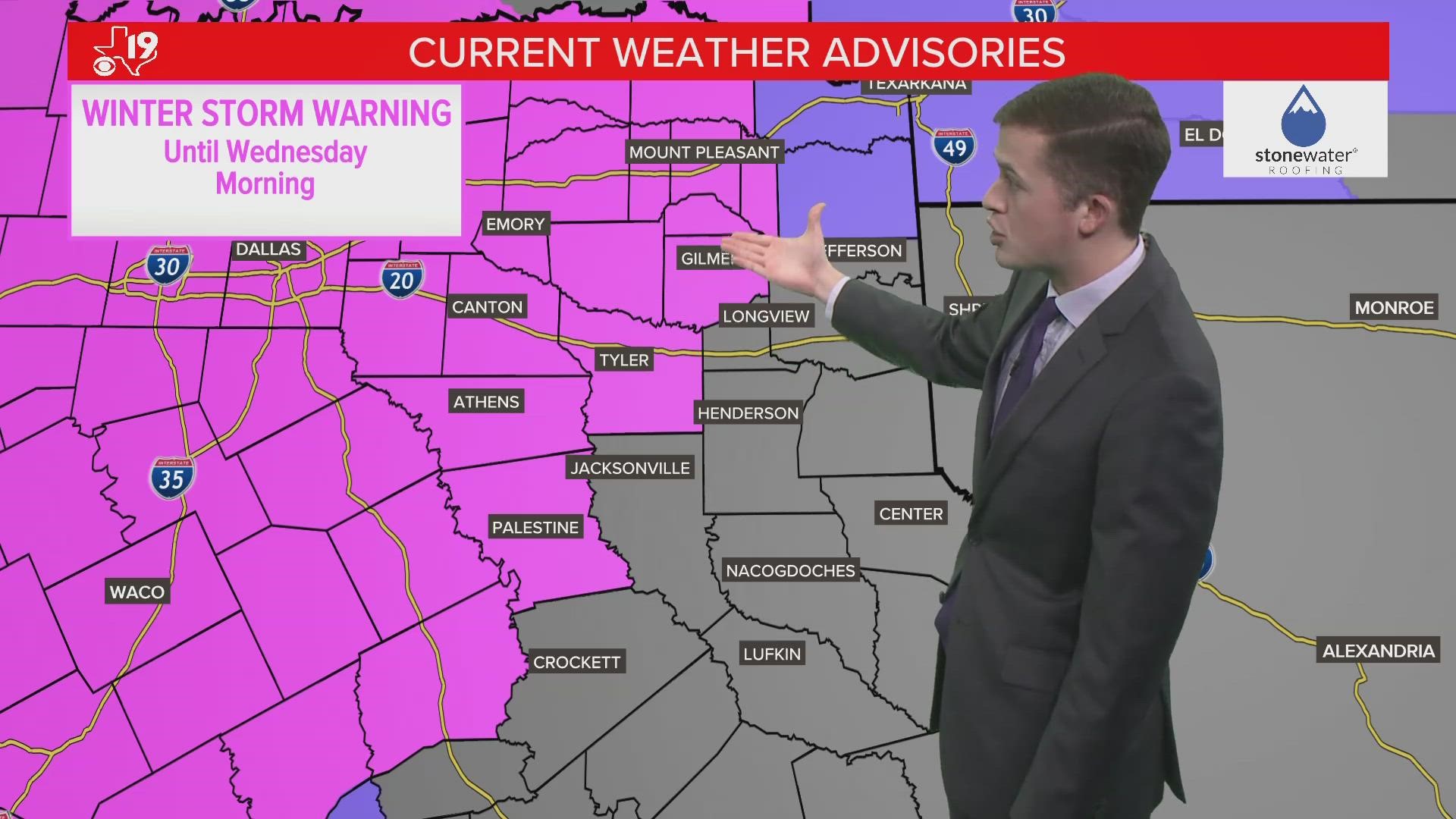TYLER, Texas — A winter storm warning has been issued for parts of East Texas, CBS19 wants to help make the most out of staying safe in the cold weather.
Here are some tips to help you be prepared for what's to come.
Dressing:
- Wear layers of warm, lightweight clothing (sweaters, light jackets)
- Wear a hat to keep your head warm (beanies)
- Cover your mouth with a scarf or face mask to protect your face from the cold air
- Wear mittens snug at your wrists to protect your hands
WHEN IT'S CHILLY OUTSIDE:
- Upper-body clothing - Top and jacket/coat (2 layers)
- Lower-body clothing - Pants
- Shoes - Warm and waterproof
WHEN IT'S COLD OUTSIDE:
- Upper-body clothing - 2 tops and jacket/coat (3 layers)
- Lower-body clothing - Pants or 2 pairs of pants (1-2 layers)
- Head - Warm hat
- Hands - Gloves
- Shoes - Waterproof boots
WHEN IT'S EXTREMELY COLD OUTSIDE:
- Upper-body clothing - 2-3 tops (insulating) and a heavy coat (3+ layers)
- Lower-body clothing - More than two pairs of pants (2+ layers)
- Head - Warm hat
- Face - Facemask
- Hands - Gloves
- Shoes - Waterproof boots
Freezing Pipes:
To keep your pipes from freezing -
- Allow for hot or cold to drip from your faucets
- Open your cabinet doors to allow the pipes to insulate and get more heat
- Make sure your heat is on and set at a temperature over 55 degrees
- If you're not at home, have someone you know check your house to see if the heat is on or drain and shut off your water system
If your pipes freeze:
- Make sure your family is aware and know how to shut off the water
- Use a hair dryer to thaw a pipe
- Be aware of the possibility for electric shock in and/or around standing water
Carbon Monoxide:
- Have a carbon monoxide detector installed
- Don't run your generator indoors
- Slightly open up a window when using a kerosene heater and follow instructions carefully
- Don't use a gas oven to heat your house
- In the case your heat goes out, keep warm by closing off rooms you don't need to use. Dress in layers and wear a hat to keep warm.
Stoves, Fireplaces and Heaters:
- Keep a screen around an open flame
- Don't use gasoline to start a fire
- Don't burn charcoal indoors
- Don't close the damper when ashes are hot
- Use safe sources of alternative heat like fireplaces and portable heaters
Pets:
- Bring your pets inside
- Provide them with shelter, food and fresh water
- Keep salt used to melt ice away from paws
Cars:
- Check your car battery, fluids and tires
- Make sure you have jumper cables
- Have an extra blanket
Driving:
- Go slow and stay aware of your surroundings
- Put more distance between you and other vehicles on the roads
- Don't get overly confident with your abilities to drive
- Make sure your vehicle is properly equipped for icy roads
- Stay at home if you can to avoid an accident
Proper steps to take when issue arises while driving:
- Braking: How you stop on a dry road will likely make you slide on an icy road. If you begin to lose control, try to steer into your curve, which can help you straighten your vehicle out on the road.
- Fishtailing: This occurs when you slide around on the road. This is also an indicator that you are traveling too fast over an icy road. You should lower your speed but avoid slamming your vehicle’s brakes. Make small movements and motions to avoid losing control. If you make too big of a turn, it may result in overcorrecting.
- Pulling over: This is not always smart to pull over on the side of an icy road. If you do this, other drivers cannot see the lines on the road, may start to slow down, lose control, and hit or slide into another vehicle. Keep moving until you find a rest area or parking lot. If you see another driver who may be in trouble, consider calling the authorities.
Black Ice:
- Black ice forms most commonly at night or in the early morning when the temperatures are at their lowest.
- Black ice tends to form on parts of the road without much sunshine. It will also form more frequently on roads that are less traveled on.
- Black ice forms readily on bridges, overpasses and the road beneath overpasses.
- You won't always be able to see black ice, but looking for it can't hurt. The roadways will appear glossier.
For more information on how to stay safe, go to weather.gov.

